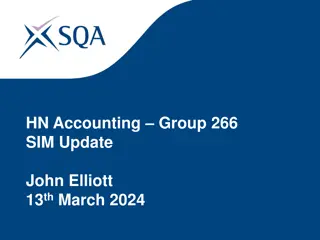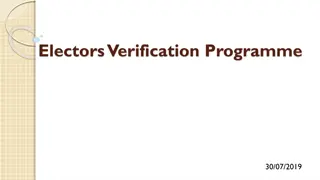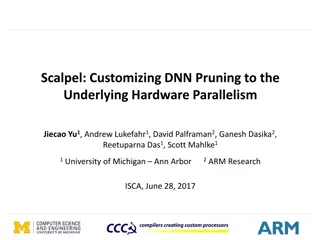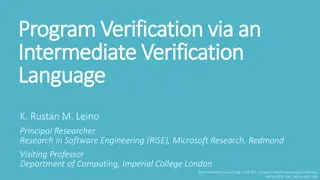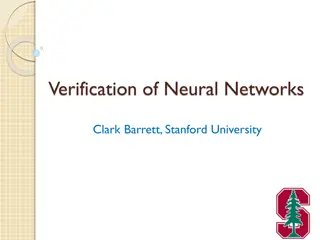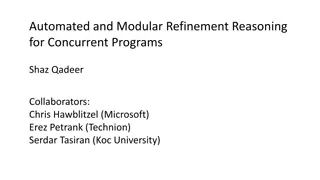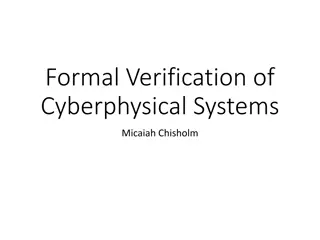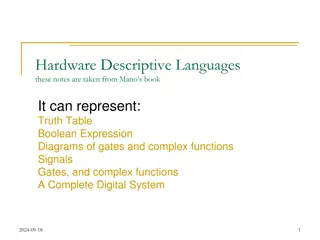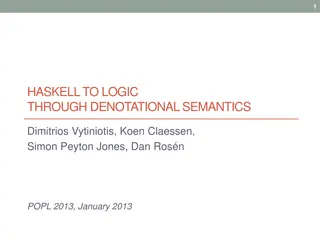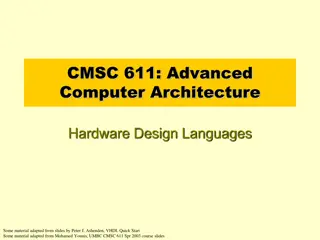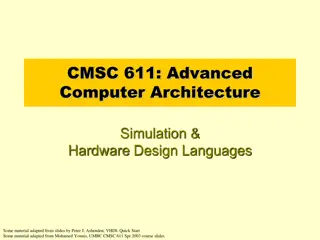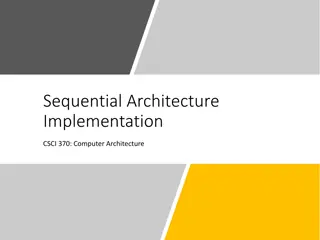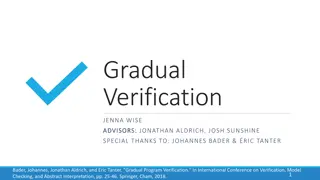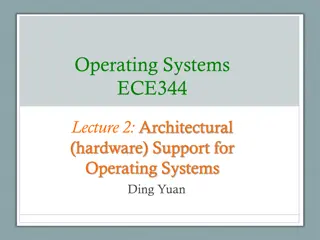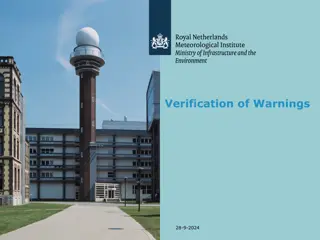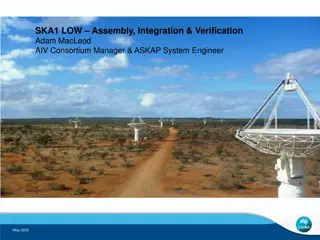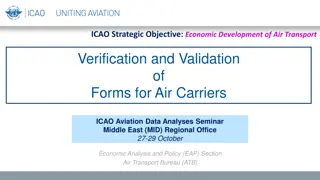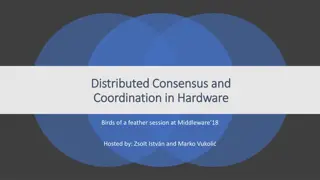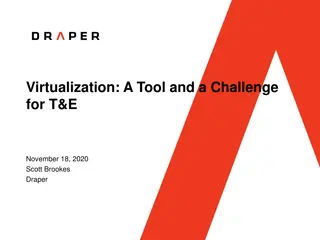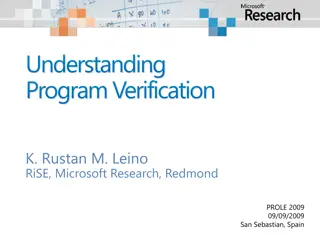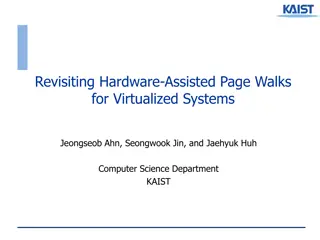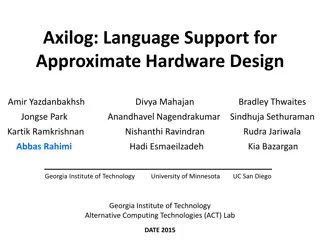Understanding Computer Organization and Architecture
A computer system is a programmable digital electronics device that processes data as per program instructions to provide meaningful output. It comprises hardware and software components, with hardware being the physical parts and software essential for driving the hardware. Computer organization fo
14 views • 71 slides
Navigating Financial Aid Verification for 2024-25
Learn about the current practices and upcoming changes in financial aid verification for the 2024-25 academic year at the SCASFAA Annual Conference. Discover the key tracking groups, standard requirements, and considerations for students and parents regarding household size and support. Get insights
0 views • 29 slides
Hold Down and Release Mechanism Hardware Simulator for Ground Deployment Testing
The project involves developing a hardware simulator for testing a Hold Down and Release Mechanism used in Mars Sample Return missions. The simulator aims to replicate the functionality of expensive flight hardware at a lower cost and with reduced lead time. Key requirements include precise activati
3 views • 8 slides
Verification Environment for ALTIROC3 ASIC in ATLAS High Granularity Timing Detector
The verification environment for the ALTIROC3 ASIC in the ATLAS High Granularity Timing Detector is crucial for the upgrades in the ATLAS HL-LHC experiment, aiming to improve particle detection performance in the forward region, mitigate pile-up effects, and provide luminosity measurement. The ALTIR
7 views • 26 slides
Global Identity Verification Market Size & Analysis _ BIS Research
The Global Identity Verification Market has witnessed exponential growth in recent years, driven by factors such as increasing instances of identity theft, regulatory compliance requirements, and the growing adoption of digital platforms. According to BIS market research the global identity verifica
10 views • 4 slides
Updates on Accounting and Verification Activities in HN Groups
Visual updates on the latest developments in HN Accounting Group 266, EV Team, Network Experience, Verification 23-24, and Next Gen Pilot. Changes in team composition, remote work trends, challenges in the sector, and advancements in assessment models are highlighted. New faces join while others in
0 views • 6 slides
Overview of Computer Hardware Components and Software Functions
Computer hardware components such as monitor, CPU, mouse, and projector are essential physical parts of a computer system, while software includes intangible programs like operating systems and utility software. Hardware components perform tasks like displaying data, processing information, and prin
8 views • 9 slides
Diploma in Hardware & Networking: Upgrade Your IT Skills
This course provides comprehensive knowledge and practical experience in computer hardware and networking, essential for managing IT infrastructure. Gain expertise in PC hardware maintenance, customer and networking support, and more to pursue a career as a Hardware and Network Engineer. Learn to as
1 views • 8 slides
Importance of Timely Verification in Care After Death
Understanding the verification process and importance of timely verification in care after death is crucial for improving the experience of death and dying for families. This session covers the definitions, process, and care after death, emphasizing the significance of timely verification in end-of-
1 views • 15 slides
Anatomy of a Computer System: Hardware Components and Functions
A typical computer system consists of hardware and software working together to perform various computational tasks. The hardware components include the central processing unit (CPU), input/output devices, storage units, and the motherboard. The CPU acts as the main brain of the computer, performing
6 views • 6 slides
Understanding Computer Hardware Components
Computer hardware encompasses the physical components of a computer system that can be touched and felt, such as the motherboard, CPU, RAM, and storage devices like HDD and SSD. Without hardware, essential software cannot run efficiently. This lesson explores the definition, importance, and various
1 views • 6 slides
Electors Verification Programme Overview
The Electors Verification Programme (EVP) is a campaign initiative encouraging citizens to verify and authenticate electoral details, including family members. Various methods such as NVSP, Mobile App, and 1950 helpline are utilized for verification. Citizens can also submit details through BLOs to
1 views • 25 slides
Criticisms and Defenses of Verification and Falsification Principles
Explore the criticisms and defenses of the Verification and Falsification Principles in religious language. Understand how believers defend the use of religious language and analyze challenges posed to the Verification Principle by notable thinkers like Swinburne, Hare, and Mitchell. Delve into resp
2 views • 15 slides
Integrated Verification and Repair in Control Plane
Modern networks face challenges from incorrect configurations affecting millions of users. This presentation discusses the integration of verification and repair processes into the control plane, aiming for consistent and policy-compliant network operations. It explores the complexities of network c
0 views • 16 slides
Optimizing DNN Pruning for Hardware Efficiency
Customizing deep neural network (DNN) pruning to maximize hardware parallelism can significantly reduce storage and computation costs. Techniques such as weight pruning, node pruning, and utilizing specific hardware types like GPUs are explored to enhance performance. However, drawbacks like increas
0 views • 27 slides
Formal Verification and Automata Abstraction in Esterel
This content delves into the applications of formal verification and automata abstraction in Esterel, focusing on techniques such as verification by abstraction of automata, boolean verification using BDDs, bounded model checking in SAT/SMT, and more. The work of Gérard Berry at the Collège de Fra
0 views • 38 slides
Program Verification via an Intermediate Verification Language
Dive into the world of program verification through an intermediate verification language with a focus on static program verification, reasoning about programs, and separation of concerns. Explore tools like Dafny and verification architectures like Boogie and Why3, along with key concepts including
0 views • 36 slides
Overview of Fly and Trajectory Scans in Data Acquisition
Fly and trajectory scans in data acquisition involve software and hardware options for acquiring data while positioners move at constant speeds. Software fly scans enable periodic data acquisition triggered by software, while hardware fly scans rely on pulses from positioners. Hardware fly choices a
0 views • 14 slides
Software Bugs and Formal Verification in Critical Systems
Software bugs have caused catastrophic events like radiation overdoses and rocket explosions, emphasizing the importance of formal verification in ensuring software correctness. Formal verification uses mathematical models to prove software correctness, offering higher assurance, especially in safet
0 views • 26 slides
Automated and Modular Refinement Reasoning for Concurrent Programs
This research explores automated modular refinement reasoning for concurrent programs, focusing on safety and correctness in operating systems and applications. Projects like Verve and Ironclad aim to achieve end-to-end security through formal verification tools and small trusted computing bases. Th
1 views • 12 slides
Formal Verification of Cyberphysical Systems and Future Certification Methods
Explore the formal verification techniques and tools used in cyberphysical systems, including KeYMaera verification tool, applications in distributed car control and adaptive cruise control, and the formal verification of ACC algorithms. The future work section highlights considerations for sensor d
0 views • 17 slides
Understanding Hardware Descriptive Languages in Digital Systems
Hardware Descriptive Languages (HDLs) are used to represent various aspects of digital systems, including truth tables, Boolean expressions, gate diagrams, and complex functions. They find application in design entry, logic simulation, functional verification, circuit synthesis, timing verification,
0 views • 19 slides
Comprehensive Solution for EU Digital COVID Certificate Verification
This solution offers face recognition, temperature monitoring, and verification of EU Digital COVID Certificates for personnel. It includes products like DHI-ASI7213X-V1-T1 and ASF172X-T1, with various unlocking modes and support for certificate verification. The system allows for accurate and fast
0 views • 7 slides
Automated Static Verification of Higher-order Functional Programs
Explore the automated static verification of higher-order functional programs, focusing on Haskell code. Learn about denotational semantics, program assertions, and tools like GHC for verification. Discover the emphasis on simplicity and structural properties for easy proofs. Consider utilizing exis
0 views • 22 slides
Understanding Hardware Design Languages in Advanced Computer Architecture
This material covers topics like behavioral correctness, timing simulations, domains, and levels of modeling in hardware design languages. It discusses functional and structural modeling, as well as the use of simulators to analyze and verify system behavior. Hardware Design Languages, behavioral de
0 views • 38 slides
Advanced Computer Architecture Simulation & Hardware Design Languages
Delve into the realms of advanced computer architecture through simulation and hardware design languages. Explore topics such as behavioral correctness, timing simulations, functional and structural modeling, geometric and algorithmic approaches, and the use of hardware design languages for behavior
0 views • 38 slides
Understanding Y86-64 Instruction Set and Hardware Control Language
Delve into the Y86-64 instruction set architecture, exploring sequential architecture implementations for computer architecture. Uncover the various instruction sets and their functionalities, such as halt, nop, call, ret, and more. Additionally, discover the building blocks of hardware, including A
0 views • 51 slides
Gradual Program Verification and its Techniques
Gradual Program Verification introduces a method where static verification is combined with dynamic verification to ensure program correctness gradually. This approach allows for partial specifications and runtime checks to be gradually applied, reducing the risk of errors and overhead in software d
0 views • 18 slides
Architectural Hardware Support for Operating Systems in ECE344 Lecture
The lecture discusses the importance of hardware support in operating systems, emphasizing the management of hardware resources and providing a clear interface to programs. It explores the fundamental relationship between operating system functionality and hardware, highlighting how hardware support
0 views • 53 slides
Warning Verification and Scoring Guidelines in Weather Forecasting Workshop
Learn about the verification of warnings, classical contingency scoring, false alarm ratio, hits, false alarms, missed alarms balance, threshold-based warning verification, and impact-based warning verification discussed in the IMS Warning workshop at KNMI Block III. Understand the importance of mai
0 views • 13 slides
Verification Modulo Versions: Towards Usable Verification
Explore the challenges and solutions in compile-time verification with CodeContracts in Visual Studio. Delve into addressing warnings, improving analysis precision, and managing syntactic baselines for a more reliable verification process.
0 views • 33 slides
SKA1 Low Assembly Integration & Verification Plan
The SKA1 Low Assembly, Integration, and Verification (AIV) Plan outlines the responsibilities of the AIV Consortium, consortium partners, and the roll-out plan for the SKA1 Low telescope. The plan encompasses user requirements validation, system verification, operational concepts, and more. It detai
0 views • 12 slides
ICAO Strategic Objective: Economic Development of Air Transport Verification and Validation Overview
This content provides an in-depth analysis of the ICAO Strategic Objective focusing on the economic development of air transport through verification and validation processes for air carriers. It includes details on forms verification, economic analysis, and policy considerations discussed at the IC
0 views • 22 slides
Distributed Consensus and Coordination in Hardware Birds of a Feather Session
Specialists in distributed consensus and hardware coordination gathered at Middleware 18 for a session hosted by Zsolt István and Marko Vukoli. The session covered topics such as specialized hardware, programmable switches and NICs, P4 language for expressing forwarding rules, and deployment exampl
0 views • 33 slides
Understanding Virtualization: Hardware Abstraction and Hypervisor Concepts
Dive into the world of virtualization with a focus on hardware abstraction and hypervisor technology. Explore the definitions and examples of hardware virtualization, hypervisors, and hardware abstraction, shedding light on how they enable multiple operating systems to coexist on a single physical m
0 views • 21 slides
Understanding Operating Systems: An Introduction and Overview
An operating system is a crucial program that manages computer hardware and serves as an intermediary between users and hardware. This chapter explores the role of operating systems in a computer system, covering components like hardware, application programs, and users. It delves into how operating
0 views • 16 slides
Overview of Program Verification Tools and Techniques
Explore the pillars of program verification, early mechanical verification systems, software quality assurance, and a spectrum of verification tools used for ensuring functional correctness, safety-critical systems, and more. Discover the role of proof assistants and automatic decision procedures in
0 views • 21 slides
Hardware-Assisted Page Walks for Virtualized Systems
Virtualization in cloud computing and server consolidation relies on hardware-assisted page walks for address translation in virtualized systems. This involves two-level address translations to ensure isolated address spaces for each virtual machine, utilizing multi-level page tables to manage memor
0 views • 32 slides
Approximate Computing in Hardware Design: A Comprehensive Overview
Explore the groundbreaking concepts of approximate computing in hardware design, which involves embracing errors to enhance resource efficiency and performance. Delve into topics such as avoiding worst-case design, criteria for approximate HDL, safety in hardware, and relaxing accuracy requirements
0 views • 31 slides
Introduction to UVM: Verification Methodologies Overview
Explore the Universal Verification Methodology (UVM) for writing modular, scalable, and reusable testbenches. Learn about UVM's key technical highlights, its support for migration towards Coverage Driven Verification (CDV), and the advantages of Constrained Random Verification (CRV) in functional ha
0 views • 20 slides





